

Medicinal Herbs Plants Uses. Use this alphabetical herb chart to find information on the healing properties and actions of medicinal plants.
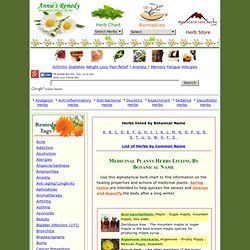
Spring tonics are intended to help quicken the senses and cleanse and depurify the body after a long winter. Buy organic bulk herbs, spices, oils and teas "Kitchen Medicine" Herb profiles and Annies favorite remedies - formatted to read on your Kindle. Learn how to get a good nights sleep, cure a cold, lower your blood sugar, lose weight, and supercharge your energy and vitality - and so much more.. Looking for something you can read offline? Yarrow Plant Study. White Yarrow Achillea Millefolium A Plant Study by Jane Ellen A requirement for involvement in the FES Certification Program is the in-depth study of a plant from the point of view of the “Twelve Windows of Perception”—an insightfull matrix within which to undertake a journey into the plant world.

This exercise in observation and research utilizes physical observation, sensation and perception, and encourages the elicitation of artistic expression in relation to the plant observed. This total immersion exercise helps to facilitate the understanding of the soul gestures and qualities that can be experienced from the plant, and also the vibrant healing energies that are present in the flower essence. We are pleased to present here, a study of White Yarrow Achillea Millefolium, undertaken by Jane Ellen, a participant in the 2003 Practitioner Training program. Establishing a resonance with the plant: It pleases me to recall our recent and much needed rain of two days ago. Growing Borage.
T's also slightly salty in flavor and so if you're on a salt reduced diet will be very useful.
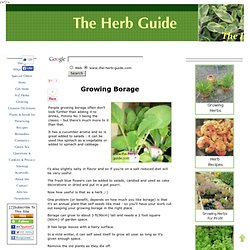
The fresh blue flowers can be added to salads, candied and used as cake decorations or dried and put in a pot pourri. Now how useful is that as a herb ;-) One problem (or benefit, depends on how much you like borage) is that it's an annual plant that self seeds like mad - so you'll have your work cut out keeping your growing borage in the right place. Borage can grow to about 3 ft(90cm) tall and needs a 2 foot square (60cm) of garden space. It has large leaves with a hairy surface. In a mild winter, it can self seed itself to grow all year as long as it's given enough space. Remove the old plants as they die off. Growing borage Well, the first year you'll have to buy a packet of borage seeds or beg some seedlings from a neighbour - but after that, watch out.
Borage likes a sunny spot with well drained fertile soil. Keep it well watered and you should have borage all year round. Borage. Botanical.com Home Page Botanical: Borago officinalis (LINN.)
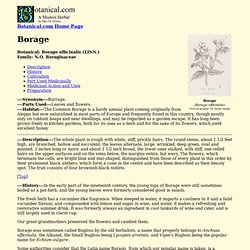
Family: N.O. Boraginaceae ---Synonym---Burrage. ---Parts Used---Leaves and flowers. ---Description---The whole plant is rough with white, stiff, prickly hairs. [Top] ---History---In the early part of the nineteenth century, the young tops of Borage were still sometimes boiled as a pot-herb, and the young leaves were formerly considered good in salads. The fresh herb has a cucumber-like fragrance. Summer savory. This herb has lilac tubular flowers which bloom in the northern hemisphere from July to September.
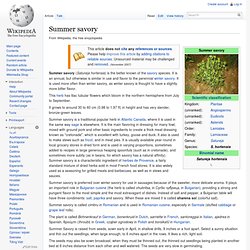
It grows to around 30 to 60 cm (0.98 to 1.97 ft) in height and has very slender, bronze-green leaves. Summer savory is a traditional popular herb in Atlantic Canada, where it is used in the same way sage is elsewhere. It is the main flavoring in dressing for many fowl, mixed with ground pork and other basic ingredients to create a thick meat dressing known as "cretonade", which is excellent with turkey, goose and duck. Guide to Growing Amaranth. Growing Guide GROWING NOTES Amaranth is responsive to nitrogen and phosphorous.
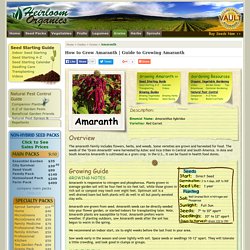
Plants grown in average garden soil will be four-feet to six-feet tall, while those grown in rich soil or compost may reach over eight feet. Optimum soil is a well-drained loam but both plants will do well in all but poorly aerated clay soils. Amaranth are grown from seed. Amaranth seeds can be directly seeded into your flower garden, or started indoors for transplanting later. Note, Amaranth plants are susceptible to frost. We recommend an indoor start, six to eight weeks before the last frost in your area. Skullcap herb uses and description. Scutellaria lateriflora Skullcap Herbal Use and Medicinal Properties Skullcap is a powerful medicinal herb, it is used in alternative medicine as an anti-inflammatory, antispasmodic, slightly astringent, emmenagogue, febrifuge, nervine, sedative and strongly tonic.
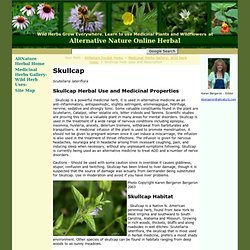
Some valuable constituents found in the plant are Scutellarin, Catalpol, other Volatile oils, bitter iridoids and Tannins. Scientific studies are proving this to be a valuable plant in many areas for mental disorders. Skullcap is used in the treatment of a wide range of nervous conditions including epilepsy, insomnia, hysteria, anxiety, delerium tremens, withdrawal from barbiturates and tranquilisers.
Cautions - Should be used with some caution since in overdose it causes giddiness, stupor, confusion and twitching. Photo Copyright Karen Bergeron Bergeron 2003.